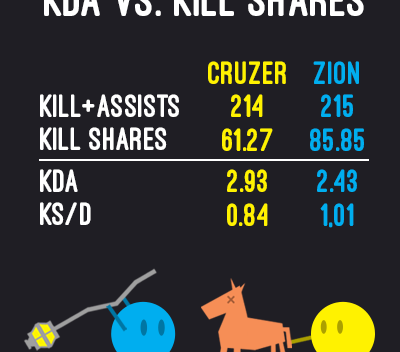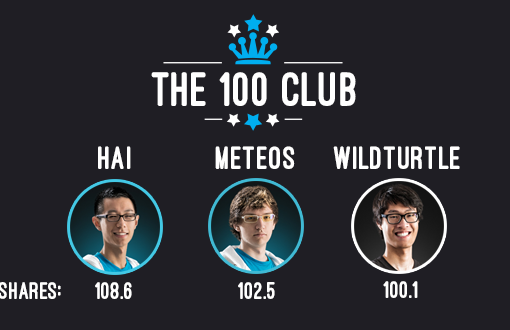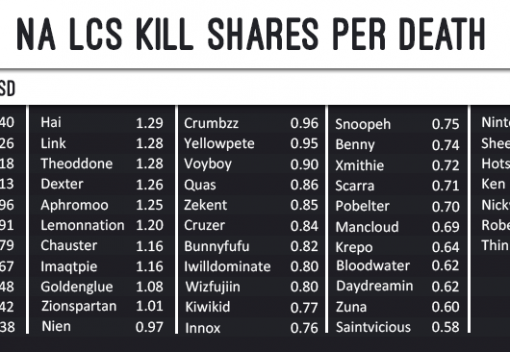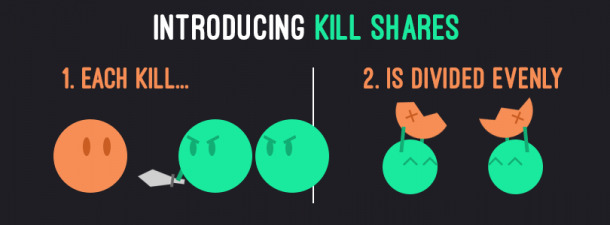Introducing Kill Shares – A New Way to Analyze Player Performance
Since the beginning of competitive League of Legends, KDA has been a weak compromise between what we want to know (How did a player perform?) and what we can quantify – the kills and deaths tabulated at the end of a match. The simple ratio of kills to deaths was a concept quickly imported from other games, primarily first-person shooters, but its use in a team game such as LoL was obviously limited. Several players can have an important role in a kill, but only one gets credit for the kill itself. From here, assists were added to the equation to get KDA. Now everybody has the benefit of the doubt for their contributions to the team efforts, but we've lost one important factor from K/D - being able to compare around a simple baseline of 1.
What are Kill Shares?
Kill shares are simple really; every death is worth one total share, split evenly amongst participants in the kill. TheOddOne helps Bjergsen score a kill with a midlane gank? Half a share to each. A kill from a 5 on 5 teamfight in which everyone gets an assist? Split the credit evenly amongst the team, a fifth of a share for each player.
What are the benefits of Kill Shares over the current system?
Not all kills are created equal. Kill shares give us a better measure of how much a player contributes to kills compared with just counting kills or assists. The less resources you can commit to successfully getting an objective, the better. Ganking top lane with three people can be a big mistake, even if the kill is picked up flawlessly. On the other hand, a solo kill forces the defending team to pick their poison: suddenly the other team is equal or better in manpower across the map, and they can only aim to defend and give up the least. Kill shares not only do a better job of assigning credit for kills, they do a better job of valuing kills relative to the players.
While counting kill shares might not give a ton of insight on its own, the real application comes when we compare it to a player's deaths, much like KDA. With KDA, there is no baseline for comparisons because the average KDA fluctuates on a number of factors, such as the amount of teamfighting vs. laning in the game.

Case Study, Zionspartan vs Cruzer:
Let's take a case study in how Kill Shares can paint a different picture than KDA: ZionSpartan and Cruzer. Cruzer's 2.9 KDA looks better on paper than Zion's 2.5 KDA, which is just above the lowest top laner in the league at 2.30. Even when looking at the team averages for KDA, they're slightly under par. A big difference as noted in a previous article is that Zion had a tremendous number of solo kills, whereas Cruzer had just 3. In several situations, Zion got kills midgame while split pushing 1v2 or 1v3. Despite dying in these fights where the KDA of 1 dragged down his average, Zion's ability to draw off 2 or 3 opponents allowed Coast to make 4v2 or 4v3 plays, without the downside of being down a man after the gank when Zion got a kill for his death. Even on a losing team (10-18), Zion maintained a KSD of 1.01. Cruzer posted a KSD of .84, which aligns more with his impact shown throughout the split than his KDA numbers would reveal.
The 100 Club:

Only three players managed to rack up over 100 kill shares during the split, but Meteos, Hai, and Wildturtle each took different paths to get there. Their teams (Cloud 9 and TSM) are hardly a surprise, and there are honorable mentions (Sneaky and Bjergsen) who barely missed this admittedly arbitrary cutoff. Of the two Cloud 9 players, their KSD scores differ dramatically – Meteos' 2.18 is third highest of all players in the league, and in a role where the average KSD is .91. The next highest jungler has only 1.28 KSD, and the average without Meteos counted is .82, which would be below the average for supports. Hai on the other hand leads the split in total Kill Shares with 108.6, but his KSD is only 1.29. This illustrates that a kill-to-death ratio, whether KSD or KDA, does not tell all the story about a player. Hai is a shot-caller and playmaker for the team, and he's comfortable making plays that he will not live through. Wildturtle collected his 100 as a solid cog in the TSM machine – while Regi and the Bjergerking combined for a total of 121 Kill Shares, Turtle posted a textbook performance that you'd expect from an AD Carry: 100 Kill Shares while dying less than twice per game, falling only 47 times in the 28 regular season matches. Whether it was dominating the jungle, making selfless plays for the team or providing a prolific and reliable presence in bot lane, these three stand atop the rankings for total kill shares in the Spring 2014 split.
This sounds great! What are the issues?
Much like KDA, we're still just measuring kills. Kills are not everything, a game cannot be won solely by killing foes. Kills are the most frequent means to force objectives, but they're not the only way. Kills don't measure sieging and rotation skills. That being said, we still understand that dying is bad, and killing enemies is good – it's just not the only thing to focus on.
This is an improved evaluation of how much each player contributes, but it's still not perfect. The clutch hook that sets your team up for a pick can still be valued the same as an unneeded Soraka ultimate to pick up some assist gold. We haven't exactly measured every player's contribution, but we're getting closer. In addition, this system still relies on Riot's definitions for kill and assist credit. They're quite accurate in most cases, but not always perfect.
Kill Shares / Deaths for NA Spring split - The Full List










